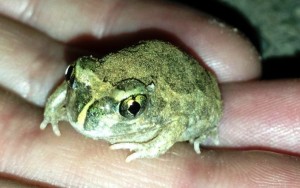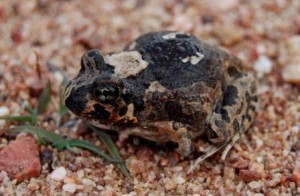- Researchers
- Carmen Amos (Postgraduate student)
Supervisors: Dr Skye Wassens & Professor Gary Luck - Project Dates
- 2012 - 2015
- Contact
- Carmen Amos Charles Sturt University – Albury camos@csu.edu.au Carmen Amos@CarmenFrogWatch
- Partners
- The Institute for Land, Water and Society at Charles Stuart University, NSW Office of Environment and Heritage
Project Info
This project examines the relationship between frog species and environmental factors which act at different scales, in the mid and lower Lachlan Catchment. Thus, engineering an improved understanding of frog responses to environmental factors at landscape and local scales, in this case, the semi-arid ecosystems of the Lachlan Catchment. These include site hydrology and spatial layout of aquatic habitats, vegetation, water quality and other aquatic organisms. The importance of environmental flow upon breeding and calling, and frogs use of microhabitats, will also be investigated. This will help identify occupancy patterns of frog species as well as what drives breeding responses on local and landscape scales. Understanding these processes will provide important information for future management decisions.
Outcomes
This study is the first large-scale, comprehensive assessment of frog communities and their habitat associations or requirements in the mid and lower Lachlan since the breaking of the Millennium Drought (circa 2010). As information on the distribution of frog species in the Lachlan is limited, the study will address some knowledge gaps which will inform adaptive management by:
- providing an assessment of the current status of frog communities in the study region of the Lachlan Catchment (i.e. community composition, species richness and distribution);
- identifying what species persisted in the region through the drought, and the key aquatic habitats they are now occupying (i.e. collect biophysical and abiotic data, including hydrology, and assess relationship with status of frog communities or 1. above);
- identify, assess and discuss important variables (including the role of environmental water in site hydrology) related to frog occupany patterns in the mid to lower Lachlan; and
- potentially use similar studies conducted in the Murrumbidgee Catchment by other members in the research team to inform discussion of previous outcomes.
In summary, outcomes from the project will inform stakeholder understanding of what conditions best aid frog survival, breeding and dispersal to ultimately improve management decisions and environmental water delivery in the future (with particular reference to managing for specific frog communities).
Progress
During September 2012 and April 2013, 49 sites located between the Great Cumbung Swamp and north of Condobolin in the mid and lower Lachlan Catchment were surveyed on four occasions. Ten frog species were identified, including the endangered Southern Bell Frog (Litoria raniformis; EPBC Act 1999).
Four dominant species were present across all wetland types and differences in the frog communities were driven by rarer species, such as Sudell’s Frog (Neobatrachus sudelli), Green Tree Frog (Litoria caerulea) and Southern Bell Frog. Preliminary assessment of data collated thus far indicates wetlands with hydroperiods of 7-13 months supported the highest diversity of frogs. Non- perennial creeks also supported diverse frog communities and should be considered as important frog habitat in conservation planning.

Juvenile Sudell's Frog recorded at Middle and Billabong creeks by Carmen Amos (Image: Carmen Amos, Charles Sturt University, November 2012)
Project News
To date, the detection of a Southern Bell Frog in the lower Lachlan, first recorded since the 70s, as well as nine other frog species provides good results for examining these relationships. “Records show the Southern Bell Frog was found around Oxley below the Lower Lachlan Swamp in 1972, and in the Booligal Swamp, the system above the Lower Lachlan Swamp, in 1978. But because that whole area dried out during the drought, they were expected to have either retracted or disappeared altogether. Finding one is a really positive sign that they are still there,” Ms Amos said (Charles Sturt University News, 19 March 2013).Related Info
Publications
Amos, C, Wassens, S, Luck, G & Spencer, J 2013, ‘Assessment of post-flood recovery of frog populations in the mid and lower Lachlan Catchment’, Abstracts of the 52 Annual Congress of the Australian Society for Limnology, 2–5 December 2013, University of Canberra, ACT.
Amos, C 2012, 'Frogs in the Lachlan Catchment' (presentation, 2012 Science Forum "Soaking Up Science", Lachlan CMA, Forbes, NSW, 14 August, 2012).
Amos, C 2013, 'Frogs in the Lachlan Catchment and how to promote them in your dam' (presentation, Healthy Farm Dam Workshop, Hovell’s Creek Landcare Group in collaboration with Boorowa Community Landcare Group, Frogmore, NSW, 16 March 2013.
Media
- "For whom the Bell Frog calls", Charles Sturt University News, 19 March 2013
- "Dam good workshop idea", Boorowa News, March 8, 2013
- "Healthy Farm Dam Workshop", Upper Lachlan Landcare Network, 1 August, 2012
Related Links
- Dr Skye Wassens, Charles Sturt University
References
Related Projects
- 'Monitoring the ecological response of Commonwealth environmental water delivered in 2013-14 to the Murrumbidgee River, (2013-2014)', Dr Skye Wassens (project leader), Institute for Land, Water and Society, Charles Sturt University, funded by Department of Sustainability, Environment, Water, Population and Communities
- Frogs of the Lachlan Fact Sheet
- Fish, Frogs and Hollow Logs, Fact Sheet, Lachlan CMA Incentive Project 2011
- 'Help save the Southern Bell Frog', Saving our Species project, NSW Office of Environment and Heritage
